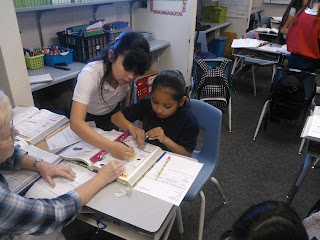It's that time again - time to show the world what we know and rock the AIMS test! Here are some inspirational videos we're watching every morning to get ourselves pumped up and ready to go!
Never Give Up - Lopez Lomong
No Excuses
I Can Do This
Make It Count
Classroom Ideas, Teaching Reflections, Parent Information, and Student Activities
Monday, April 16, 2012
Wednesday, April 4, 2012
Electromagnets: Exploring the Connection Between Electricity and Magnetism
Michael Faraday discovered the relationship between electricity and magnetism. Using this discovery, he invented the electromagnet which uses an electric current to create a magnetic field. Using our materials from SRP, we made electromagnets today and conducted an inquiry experiment in which we answered the question "How can we make an electromagnet stronger?" We learned that an electromagnet with no power source doesn't work. Also, an electromagnet with 50 coils of wire is stronger than an electromagnet with only 30 coils of wire.
 |
| One group's electromagnet |
 |
| The electromagnet at work! |
Tuesday, April 3, 2012
8th Grade Holocaust Museum
Our class recently finished reading Number the Stars. Now we are reading Sadako and the Thousand Paper Cranes in order to compare and contrast Annemarie Johansen's WWII experience with Sadako Sasaki's post-WWII experience. Coincidentally, the 8th graders in Ms. Clark's class just finished studying the Holocaust and created a Holocaust Museum for our school to tour. We visited the museum and got to ask the 8th grade tour guides lots of questions about the Holocaust. At the end of the tour, we all filled out a reflection where we wrote a wish for the world or a reflection about what the Holocaust can teach us today. Thanks for bringing our learning to life, Ms. Clark's Class!
 |
| Talking to a 8th Grade Tour Guide |
 |
| Reflections |
Seeing the Lightbulbs Turn On!
Thanks to a wonderful professional development provided by SRP, Miss Barber's class received some amazing materials to help us investigate electricity! We learned that the flow of electrons is called an electric current and that's the type of electricity that batteries produce. To demonstrate, we set up a battery on the floor with tape. Then the students stood on the wires in pairs of protons and electrons (+ and - stress balls) with a group of protons on the + side of the battery and a group of electrons on the - side of the battery. Finally we modeled the flow of electrons and showed how a battery "goes dead."
The next day, we created simple circuits, series circuits, and parallel circuits in groups. Thanks for helping us experience electricity, SRP!
 |
| Which circuit is a parallel circuit? Which is a series circuit? |
Subscribe to:
Comments (Atom)














